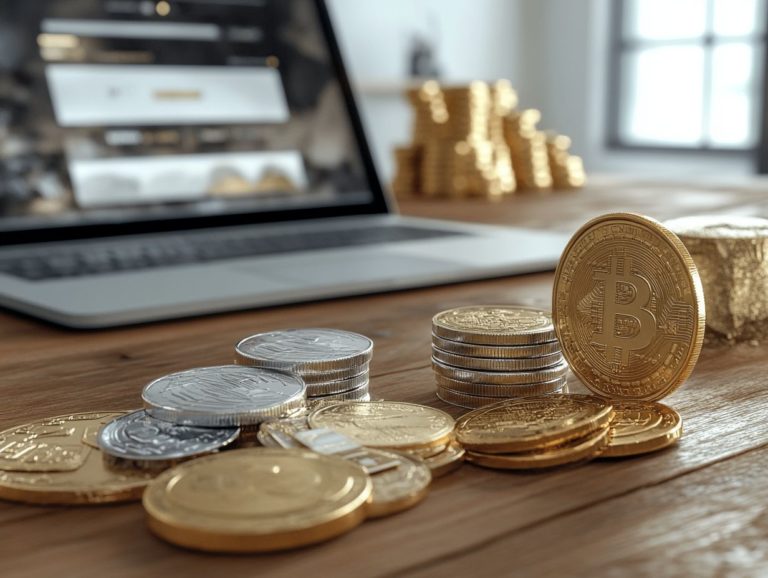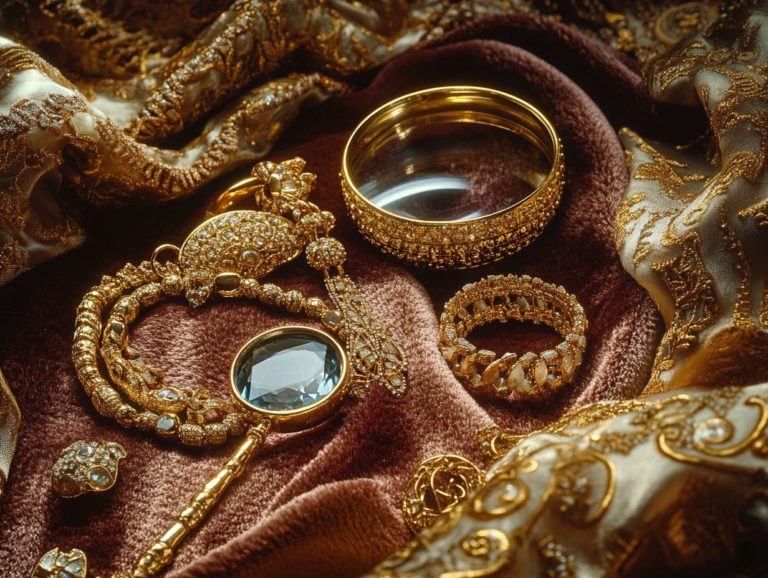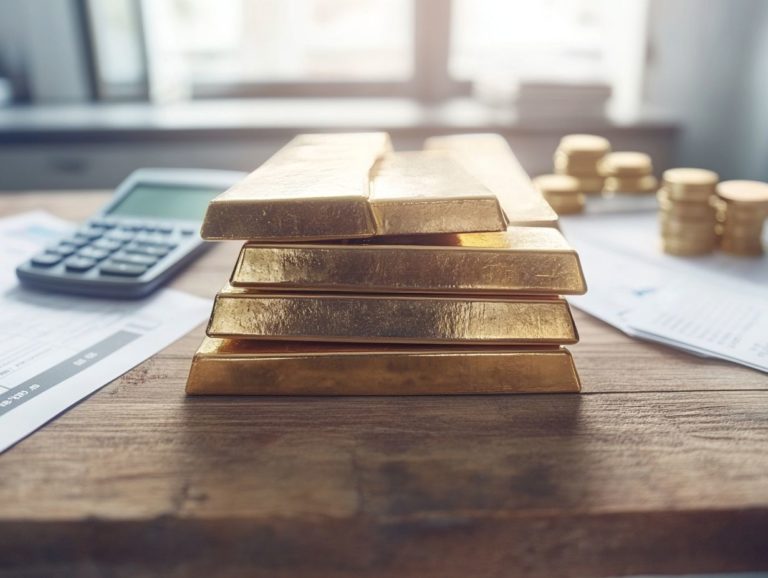5 Reasons to Invest in Silver Right Now
As the investment landscape evolves, silver presents itself as a compelling option for you. Currently undervalued, this precious metal offers unique opportunities for diversification and the potential for significant returns.
Beyond its traditional applications in jewelry and coins, the rising industrial demand showcases silver s remarkable versatility across various sectors.
Don t miss out on the chance to invest in silver today! This article delves into five key reasons for you to consider investing in silver, addressing the factors that influence its price, associated risks, and strategies to navigate market fluctuations.
Uncover why silver could be an essential addition to your investment portfolio.
Contents
Key Takeaways:
- Silver is currently undervalued, presenting a prime investment opportunity.
- Diversifying with silver can help protect your assets.
- Industrial demand is expected to drive silver’s long-term value.
- Investing in silver can yield high returns during economic uncertainty.
- Silver serves as a safeguard against inflation and economic downturns.
1. Silver Is Undervalued
Silver often flies under the radar in the investment world, despite its notable potential especially when current market prices linger below the historical averages we’ve seen over the decades.
Experts like Dominic Frisby from MoneyWeek have meticulously analyzed silver price fluctuations since the 1980s. Their insights shed light on just how promising this metal can be.
This underappreciated asset isn t just valued for its industrial uses; it also serves as vital protection against rising prices and the loss of money value. Investors frequently seek refuge in silver during economic turbulence, recognizing its longstanding reputation as a reliable store of value.
Market analysis reveals that numerous factors, such as geopolitical tensions and central bank policies, contribute to its price volatility. Allegations of market manipulation add another layer of complexity.
For those considering an investment in silver, the metal presents unique advantages compared to other precious metals. Plus, it remains accessible to everyday investors eager to diversify their portfolios.
2. Adding Silver to Your Investment Portfolio
Adding silver to your investment portfolio is a smart diversification strategy. It helps mitigate the risks associated with market fluctuations and economic challenges, while offering diverse investment avenues, such as silver stocks, Exchange-Traded Funds (ETFs), and physical silver coins.
By incorporating silver, you can leverage the metal’s historically stable value and its reputation as a safe haven during market turbulence. Silver stocks offer exposure to mining companies that can generate impressive returns, while ETFs provide a convenient way to maintain silver without the hassles of physical storage.
Purchasing silver coins not only adds a tangible asset to your collection but also enhances liquidity and aesthetic appeal.
Ultimately, integrating silver into your diversified portfolio can serve as a hedge against inflation and geopolitical uncertainties, allowing you to create a more resilient financial strategy.
3. Increasing Industrial Demand
The growing demand for silver in industrial applications, especially within technology and consumer products, underscores its versatility and potential for substantial market growth. This reinforces its status as a valuable precious metal investment.
This surge is primarily fueled by silver’s crucial role in solar energy systems, where its exceptional conductivity and reflectivity significantly enhance efficiency. The electronics sector also relies heavily on silver for essential components like circuit boards and soldering materials, further amplifying demand.
Silver’s antimicrobial properties make it essential in the medical field, particularly for wound dressings and sterilization applications.
As industries increasingly embrace these technologies, the rising need for silver aligns with escalating prices, creating a compelling opportunity for investors eager to fortify their portfolios with an invaluable asset.
4. Potential for High Returns
Investing in silver has great potential for high returns, especially given recent price changes and trends that indicate a positive outlook for the silver market. This is exciting for investors looking for short-term profit opportunities.
Silver typically bounces back impressively after downturns. Increased demand in industry and its role as protection against inflation drive this trend.
With current market indicators showing growing interest in silver, you have a prime opportunity to navigate through price fluctuations.
Identify key moments to invest when prices dip to maximize your gains while minimizing risks.
5. Hedge Against Inflation and Economic Uncertainty
Silver is a safe-haven asset and a strong way to protect your money from losing value due to rising prices, especially during economic turmoil and currency depreciation. It helps safeguard your wealth against geopolitical risks and financial instability.
Historically, demand for silver tends to surge in times of crisis. For example, during the 2008 financial collapse, investors rushed to precious metals to protect their portfolios from market instability.
Major geopolitical events, such as trade wars and military conflicts, have also caused silver prices to spike as uncertainty drives investors toward tangible assets. This shows that regardless of the economic landscape, silver remains a reliable buffer against inflationary pressures, valued by those who want to safeguard investments amidst ever-fluctuating market conditions.
What Are the Different Ways to Invest in Silver?
Investing in silver gives you various options, whether you purchase physical silver, invest in silver coins, stocks, or ETFs. This flexibility allows you to tailor your approach based on your risk tolerance and current market conditions.
Each method comes with its own advantages and challenges. For instance, while physical silver offers the comfort of tangible assets, it requires secure storage and can raise liquidity concerns in urgent financial situations. Silver coins can be both beautiful and potentially valuable, but their prices fluctuate significantly based on rarity.
Investing in stocks and ETFs provides easier access to the silver market, along with the benefit of liquidity. However, these options can expose you to stock market volatility and incur management fees.
By understanding these factors, along with supply constraints and market trends, you can enhance silver’s role in your diverse investment portfolio.
What Factors Affect the Price of Silver?
The price of silver is influenced by various factors, including supply constraints, inventory levels, and the broader economic landscape, all contributing to its well-known price volatility.
At the heart of this volatility are the dynamics of supply and demand. Any shifts in mining production or industrial usage can dramatically change price levels. For example, during the COVID-19 pandemic, supply disruptions triggered a significant price spike, while recent manufacturing recovery trends have intensified industrial demand.
Geopolitical risks, such as trade tensions or political instability in silver-producing nations, introduce uncertainty that often nudges investors toward safe-haven assets. Historical instances, like the sharp fluctuations seen in the late 1970s driven by inflation fears, highlight how market trends and changing investor sentiments shape the value of silver over time.
What Are the Risks Associated with Investing in Silver?
Investing in silver comes with its own set of natural risks, including price volatility and the potential for market corrections. These factors can affect your short-term profits and overall investment strategies.
The unpredictable nature of metal markets means you’ll often see fluctuations driven by changing demand, economic indicators, and geopolitical events. This uncertainty can catch investors off guard with sudden price drops.
External economic factors such as inflation, currency strength, and shifts in mining production can further impact silver’s value. A sudden market shift might cause panic selling, leading to heightened losses.
To effectively navigate these risks, diversification is essential. Consider blending silver with other asset classes and implementing stop-loss orders to safeguard against severe declines. This allows for a more balanced approach to capital preservation.
How Can One Determine the Right Time to Invest in Silver?
Determining the right time to buy silver requires a keen eye for market analysis, a solid grasp of silver market trends, and the ability to spot potential buying opportunities that arise from economic challenges or supply inelasticity.
By closely monitoring various market signals, such as fluctuations in demand and shifts in investor sentiment, you can significantly improve your chances of making informed decisions.
Analyzing historical price patterns offers valuable insights into how silver has responded in different economic climates, equipping you with a more nuanced understanding of potential future movements.
Additionally, keeping an eye on vital economic indicators like inflation rates and central bank policies can further refine your timing strategies.
A well-crafted investment strategy not only aids in pinpointing optimal entry points but also builds a strong foundation for maximizing your returns over the long term. Act quickly to seize opportunities when they arise.
What Are the Long-Term Trends for Silver Prices?
Long-term trends in silver prices reveal a sophisticated interplay of historical averages and contemporary market analysis, indicating substantial investment potential for those willing to look beyond fleeting fluctuations.
Throughout the years, silver has demonstrated notable volatility compared to other precious metals like gold and platinum. It is often influenced by geopolitical events and economic shifts. When examining historical performance, consider the silver-to-gold ratio, which has shown significant variation and provides valuable insights into relative value.
As demand for silver continues to climb especially in burgeoning sectors like technology and renewable energy projections suggest that this metal could experience a remarkable resurgence. Now is the time to act to benefit from these emerging opportunities.
Additionally, advancements in extraction techniques are set to enhance mining efficiency, further influencing supply and price dynamics. This positions silver not merely as a historical asset but as a forward-looking opportunity worth your attention.
How Can Silver Be Used as a Hedge Against Economic Downturns?
Silver stands as a steadfast hedge against economic downturns. It serves as a safe haven during times of financial turbulence and market uncertainty.
Throughout history, various economic crises have highlighted the value of silver as a protective asset. Take the Great Depression of the 1930s, for example. Many investors turned to silver to safeguard their wealth when traditional currency faced severe devaluation.
Fast forward to the 2008 financial crisis, and you would have seen silver prices soar as market volatility drove investors to seek tangible assets.
The rationale for including silver in your investment portfolio during challenging times lies in its intrinsic value and historical performance. As a physical commodity, silver tends to retain its purchasing power, acting as a buffer against inflation and enhancing your portfolio’s diversification.
Frequently Asked Questions
What Are the Top Reasons to Invest in Silver Right Now?
The top 5 reasons to invest in silver right now are:
- Increasing industrial demand.
- Potential for price appreciation.
- Hedge against inflation.
- Portfolio diversification.
- Low entry point for investment.
How Does Industrial Demand Affect the Silver Market?
Silver is a key component in many industries, such as electronics, solar panels, and medical equipment. As these industries continue to grow, the demand for silver will also increase, potentially leading to price appreciation for silver investors.
For personalized advice, consider consulting a financial advisor to explore your investment options.
Why is silver a good hedge against inflation?
Silver has long been considered a safe haven during inflation. As fiat currency loses value, silver often gains value, protecting your purchasing power.
How does investing in silver diversify a portfolio?
Silver’s low correlation with stocks and bonds helps balance portfolio volatility. By including silver, you spread risk and boost potential returns.
Is now a good time to invest in silver?
Timing is crucial in investing. Right now, silver prices are relatively low, presenting a fantastic opportunity to enter the market.
With demand likely to rise, investing in silver could be a smart move.
What are the potential downsides of investing in silver?
Every investment carries risks. Silver prices can be unpredictable, and there’s no guarantee of returns.
Storing physical silver can pose challenges. It s essential to weigh these factors before deciding to invest.






